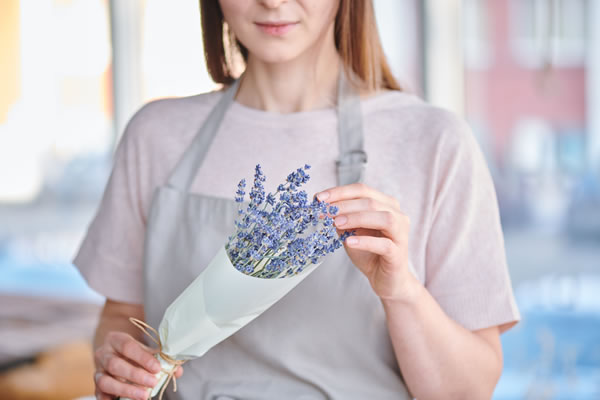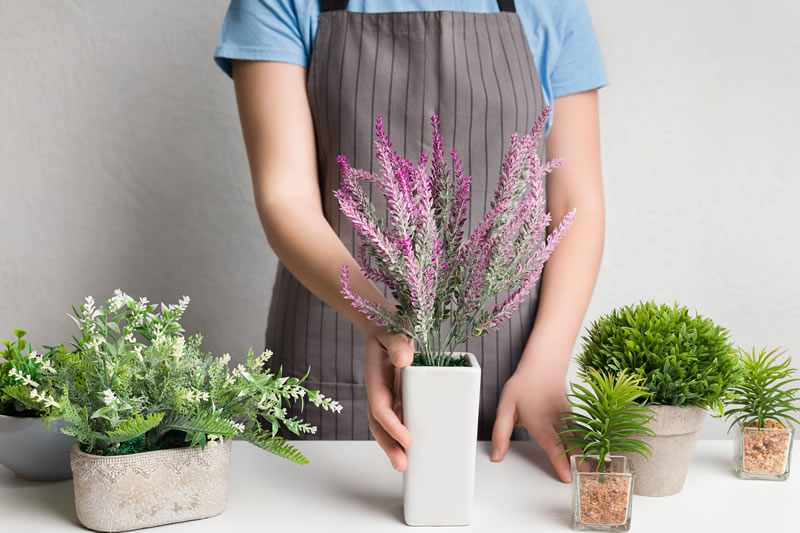The wonderful aroma of lavender, as well as its bright and vivid color and is beginner friendly, it makes this a popular choice for many indoor gardeners.
There are different types of lavender. Three distinct types: Spanish, English and French. Each have different characteristics, smell, benefits and shape.
But can you grow lavender indoors?
You can grow lavender indoors. The French Lavender is best suited to growing indoors as it requires less sunlight than the other lavender types. It is also the most versatile. The French Lavender is 50% taller than the other types and has a smaller flower than the English and Spanish Lavender.
Interestingly the name Lavender is derived from a Latin word which means ‘to wash’. Lavender, because of its sweet welcoming aroma, was used by Romans to scent their beds, clothes and even their baths!
Very similar to what many of us do today.
Now we know that it is possible to grow lavender indoors, let’s look at the methods.
How to Grow Lavender Indoors
Although lavender can be easy to grow, it is demanding in its requirements.
I’ve found this out a time or two and can share some of that experience with you.
Lavender is native to the Mediterranean. For those of you with any experience of the Mediterranean you’ll realize it’s a very hot dry environment with plenty of sunshine.
This mimics many U.S. Mid-West and Southern states but many of us indoor gardeners either do not have the outside space or the right climate with which to grow successfully.
Any water needs to be able to drain well and it needs as much sunlight as you can give it. This may mean rotating or re-positioning your lavender pots whilst indoors.
Grow Lavender from Cuttings – Step by Step
Cuttings can be a preferred starting point for growing your own lavender. It’s generally a faster process and often leads to better results all round.
Unfortunately, you will need an existing lavender plant at the right maturity for cutting to get started. If this isn’t an option, you may want to start with lavender seeds. We will cover this further on in this post.
Here are the instructions on how to grow lavender indoors from cuttings:
- Take your cuttings from a mature lavender plant – but not one already flowering
- Dip into some preprepared rooting hormone powder – between 0.1% and 0.3% IBA, to encourage the growth
- Use a prefilled soil tray and plant the cutting into the soil
- Your soil should not be rich in nutrients or hold water
- Once your tray is full of cuttings take inside and place under a grow lamp to encourage the rooting
- A 100w grow lamp is fine
- After around 2-4 weeks you should notice the roots coming through the bottom of your soil
- Once this happens, after around 4 weeks, you can take the plants from the tray and into their own pot – around 10cm plant pots should be fine for the size of lavender so far
- Make sure they get as much sunlight as possible!
- As the stems grow, and plant develops you will want to trim as it grows to encourage fresh growth
- As they grow you will need to move them to larger containers
Grow Lavender from Seeds – Step by Step
Growing lavender from seed is a great to get going from scratch, or if you don’t have any lavender cuttings.
Here are the instructions on how to grow lavender indoors from seeds:
- Take a small tray and fill with regular soil
- Place a seed into each of the tray cells
- Lavender seeds are extremely tiny, and it can be difficult to just put one into each tray space, but putting more than one isn’t a big deal
- Under a grow tray you should start seeing some seedling coming through between 14 days to 18 days
- After 6 to 8 weeks, you should be able to take the plants from the tray and into their own 10cm pot
- They need plenty of sunlight, give them as much as you can through your window
- Trim the stems as it grows
- You will need to move the lavender plants to larger containers as they grow and consume their space
Growing lavender is a slow process, like any plant or herb. It takes time, care and nurturing.
Do not over-water lavender. It doesn’t need it.
Types of Lavender

There are three distinct types of lavender. They all have different characteristics and one of these in particular is recommended for indoor gardening, because it’s the easiest of the lavenders to grow.
Let’s have a look at the different types, and which you should focus your efforts on in your indoor garden.
Spanish Lavender
The Spanish Lavender variety requires lots of sunshine, so not always best suited to the indoors.
It often blooms first compared to the other lavender types, so if you have all three types in your garden and notice one starting to bloom, it almost certainly is your Spanish type.
It has a distinct looking pineapple shaped flower, that almost looks like it’ll take off in flight with a pair of wings on top.
It isn’t the most fragrant of the lavender types, but is colorful, fragrant and blooms twice during every season.
French Lavender
The French Lavender is the easiest of the three types to grow, and very much suited to indoor gardening.
The French Lavender is easy to spot as it’s by far the tallest of the lavender types!
The flowers are much smaller and thinner, not much thicker than the stems themselves.
English lavender
The English Lavender is very versatile. If you’ve ever seen Lavender Chocolate or even Lavender Cheese, it’s more than likely to have come from the English Lavender variety.
It’s by far the shortest of the lavender types, it does though offer bright vivid colors as well as a stronger fragrance than the Spanish variety, but it doesn’t quite compete with French Lavender for fragrance.
Julie, at the Sauvie Island Lavender Farm, offers a good explanation and gives a good visual comparison between the different lavender types, so you can see exactly what they look for – check out the video below:
How to Care for Indoor Grown Lavender
Sunlight, sunlight and more sunlight!
Lavender needs sunlight.
As it comes from the Mediterranean, it grows in what can be considered quite a harsh environment by some indoor plant standards.
Watering is fine but you should use a soil that doesn’t retain moisture. It should naturally drain away.
Placement of your lavender inside really does affect the success of its growth. Give it as much of the suns rays as possible, especially during winter when the sun hangs in our sky for less hours.
Lavender requires 4 hours of sunshine minimum per day but can happily enjoy and soak up 10 hours or so daily.
Your soil should be around ph7 or ph8 for best consistency.
Frequently Asked Questions
Here are some answers to regularly asked questions around growing lavender indoors.
Can lavender grow in low light?
It is very difficult to grow lavender in low light. As lavender is native to the Mediterranean they generally thrive on long hours of natural sunlight and require a minimum of 4 hours of sunlight a day. When rooting lavender, a 100 watt indoor grow lamp can be used.
Can lavender grow in pots?
Lavender can quite comfortably grow in pots. Lavender grows and expands and as a result will need to be moved to larger pot sizes as it increases in size.
Does Lavender need direct sunlight to grow?
Lavender does require a lot of direct sunlight to successfully grow. 10 hours of sunlight is recommended, but a minimum of 4 hours is required. Indoor gardeners are encouraged to place lavender in south facing windows to capture as much sunlight as possible.
In Conclusion – Growing Lavender Indoors
Growing lavender indoors can bring a beautiful, sweet smell to your indoor garden.
It is possible to grow lavender indoors but requires strategic placement of lavender pots, as well as the best practises to get your lavender seed or cutting rooted.
